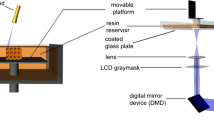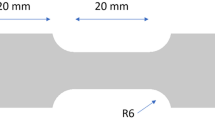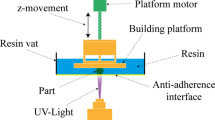Abstract
Three-dimensional photoelasticity using the stress-freezing technique is dependent on the production of resin models that do not possess any residual stresses from the manufacturing process. The traditional methods of production involve casting to shape or machining from solid blocks using thermo-setting resins. These methods are expensive and time-consuming, with models typically requiring days for preparation. The rapid-prototyping technique of stereolithography employs similar resins and allows complex components to be built in a matter of hours. However, the residual birefringence associated with the stereolithographic process has so far inhibited its routine use in photoelasticity. A four-centre study has been conducted in an attempt to understand the mechanisms generating this birefringence and to investigate methodologies for producing models free of stress and birfringence. The mechanical behavior of stereolithographic and thermo-setting resins have been compared at room temperature and under stress-freezing conditions.
Similar content being viewed by others
References
Fessler, H., “An Assessment of Frozen Stress Photoelasticity,”J. Strain Anal.,27 (3),123–126 (1992).
Durelli, A.J., Applied Stress Analysis, Prentice-Hall, Englewood Cliffs, NJ (1967).
Burguete, R.L. andPatterson, E.A., “A Comparison of Analytical, Finite Element, and Photoelastic Results for a Cylinder in Contact with an Elastic Half-space,”Modern Practice in Stress and Vibration Analysis, M. Gilchrist (ed),Balkema, Rotterdam, 367–372 (1997).
Patterson, E.A., “A Renaissance in Optical Techniques,”J. Strain Anal.,33 (2),i-ii (1998).
Ajovalisit, A., Barone, S., andPetrucci, G., “A Review of Automated Methods for the Collection and Analysis of Photoelatic Data,”J. Strain Anal.,33 (2),75–92 (1998).
Cen, M., Tomlinson, R.A., Patterson, E.A., andHickman, L.J., “Integrated Birefringence Applied to Solids and Fluids-Review,” EXPERIMENTAL MECHANICS, Allison I.M. (ed),Balkema, Rotterdam, 507–512 (1998).
Proceedings of the 10th Annual Symposium on solid Freeform fabrioation, Austin TX, 1999.
Jacobs, P.F., Stereolithography and Other RP&M Technologies: From Prototyping to Rapid Tooling, American Society of Manufacturing Engineers Press, New York (1996).
Decker, C. andMoussa, K., “A New Photoinitiator for Ultra Lightinduced Polymerisation,”Polymer Science C,27,347–354 (1989).
Decker, C., “Photoinitiated Curing of Multifunctional Monomers,”Chimia,47,378–382 (1993).
Decker, C. andMoussa, K., “Recent Advances in UV-curing Chemistry,”Coatings Technology,65,49–57 (1993).
Bernhard, P., Hofmann, M., Schulthess, A., andSteinmann, B., “Taking Lithography to the Third Dimension,”Chimia,48,427–430 (1994).
Weissman, P.T., Bolan, B.A., and Charcoft, R.P., “Measurements of Linear Shrinkage and the Residual Stresses Developed During Laser Photopolymerisation,” Proc. 3rd Int. Conf. Rapid Prototyping, Dayton, Ohio, 103–112 (1992).
Iwanaga, S., Ohkawa, M., Igarshi, K., and Kurihari, F., “Influence of Material Characterisation on Dimensional Stability,” Proc. 3rd Int. Conf. Rapid Prototyping, Dayton, Ohio, 77–89 (1992).
Williams, R.E., Kormaragiri, S.N., Metton, V.L., andBishu, R.R., “Investigation of the Various Build Methods on the Performance of Rapid Prototyping (Stereolithography),”Mater. Proc. Technol,61,173–178 (1996).
Duclos, A.M., Jezequel, J.Y., andAndre, J.C., “Three-dimensional Machining with a Laser: Polymer Deformation Induced Shrinkage Phenomena,”Photochem. Photobiol. A: Chem.,70,285–299 (1993).
Karrer, P., Corbel, S., Andre, J.C., andLougnot, D.J., “Shrinkage Effects in Photopolymerisable Resins Containing Filling Agents: Application to Stereolithography,”Polym. Sci. A: Polym. Chem.,30,2715–2723 (1992).
Fu, J.Y.H., Choo, Y.S., Nee, A.Y.C., Lu, L., andLee, K.C., “Improvement of the UV Curing Process fortthe laser Lithography Technique,”Mater. Design,16,23–32 (1995).
Lu, L., Fuh, J.Y.H., Nee, A.Y.C., Kang, E.T., Miyazaura, T., andCheah, C.M., “Origin of Shrinkage, Distortion, and Fracture of Photopolymerised Material,”Mater. Res. Bull.,30,1561–1569 (1995).
Fuh, J.Y.H., Choo, Y.S., Lu, L., Nee, A.Y.C., Wong, Y.S., Wang, W.L., Miyazaura, T., andHo, S.H., “Post-cure Shrinkage of Photo-sensitive Material Used in Laser Lithography Process,”J. Mater. Process. Technol.,63,887–891 (1997).
Nau, W., Dooley, R.L., Ogale, A.A., Jara-Almonte, C.C., and Bachi, A., “Embedding Sensors Using Stereolithography,” Proc. 3rd Int. Conf. Rapid Prototyping, Dayton, Ohio, 121–130 (1992).
Buhler, N., “New materials by photopolymerisation,”Chimia,47,375–377 (1993).
Johnson, D.H., Roth, D.E., and Sorovetz, T.A., “Effects of Variable Poisson's Ratio in FEA Verification of SLA Prototypes,” SEM Conf. on Integration of FEA and Structural Testing With Rapid Prototyping, Dearborn, Michigan,32 (1995).
Lu, L., Fuh, J.Y.H., Choo, Y.S., Nee, A.Y.C., andLee, K.C., “Material Characterisation of Photo-fabrication Process,”Mater. Manu. Process.,10,653–666 (1995).
Lightman, A.J., andAnderson, R.E., “Studies of Photopolymerisation for Stereolithography Using Optical Diagnostics,”SAE Trans. J. Aerospace,1,303–309 (1991).
Steinchen, W., “Photopolymers from Stereolithography for Photoelastic Investigation,”Kunstoffe-German Plastics,83,385–388 (1993).
Steinchen, W., “Photoelastic Cuts Parts Development Costs,” Photonics Spectra, 157–162 (May 1994).
Steinchen, W., Kramer, B., and Kupfor, G., “Experiences Using STLepoxies for Photoelastic Investigations,” Proc. VIII Int. Congr. Exp. Mech., Nashville, USA, 5–6 (1996).
Burguete, R.L., andPatterson, E.A., “Photomechanical Properties of Some Birefringent Polymers Around Their Glass Transition Temperatures,” EXPERIMENTAL MECHANICS,36 (4),399–403 (1996).
Gilbert, J.A., Maurice, M.D., Moser, M.R., and Bording, R.C., “Residual Stresses in Stereolithography Models,” Proc. SEM Spring Conf., Bellevue, Washington, 319–332 (1997).
Hendry, A.W., Photoelastic Analysis, Pergamon Press, Oxford (1966).
Patterson, E.A. andWang, Z.F., “Towards Full-field Photoelastic Analysis of Complex Components,”Strain,27 (2),49–56 (1991).
Haake, S.J., Wang, Z.F., andPatterson, E.A., “Evaluation of Full Field Automated Photoelastic Analysis Based on Phase-stepping,”Exp. Tech.,17 (6),19–25 (1993).
Anderson, R.E. andLightman, A.J., “Measurement of the Refractive Index Variations with Temperature of a Photomonomer,”Appl. Opt.,30,3791–3793 (1992).
Author information
Authors and Affiliations
Rights and permissions
About this article
Cite this article
Curtis, J.D., Hanna, S.D., Patterson, E.A. et al. On the use of stereolithography for the manufacture of photoelastic models. Experimental Mechanics 43, 148–162 (2003). https://doi.org/10.1007/BF02410496
Received:
Revised:
Accepted:
Issue Date:
DOI: https://doi.org/10.1007/BF02410496




